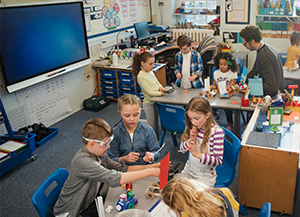Creating a Sustainable Classroom
Sustainable Classroom ideas for each and every school
As we head into the Fourth Industrial  Revolution, we are transforming our cities to make them both smarter and more sustainable. These smart cities will be powered by artificial intelligence, autonomous things, immersive technologies, the Internet of Things, and much more.
Revolution, we are transforming our cities to make them both smarter and more sustainable. These smart cities will be powered by artificial intelligence, autonomous things, immersive technologies, the Internet of Things, and much more.
To remain relevant, enterprises across industries are now in a race to digitally transform their infrastructure to meet the demands of the digital age. When it comes to education, the goals are more less the same. But unlike most industries, schools are a little bit different.
To get students ready for higher education and the demands of modern workplaces, schools have to be transformed into smart spaces.
Smart Space, what is that?
According to Gartner, a smart space can be described as a physical or digital environment where humans and technology-enabled systems can engage in an increasingly open, coordinated, intelligent, connect ecosystem.
Smart spaces are evolving along the following critical dimensions:
- Connectedness
- Coordination
- Intelligence
- Openness
- Scope
Smart spaces are created from individual technologies that are brought together to enhance interaction and collaboration. For schools, this means incorporating the best tools technology has to offer to improve learning experiences and teacher and student engagement.
However, K-12 schools can’t adopt new technology on a whim. They have to contend with tight budgets (that are often stretched over five years) and still deliver high-quality education.
Students today are also different from the generations before them. They are highly tech-savvy and environmentally conscious.
To effectively cater to the demands of present and future generations of students, schools around the country need to create “sustainable classrooms.” This approach creates digital classrooms while reducing the institution’s overall carbon footprint.
Sustainable Classroom, what is that?
 A sustainable classroom is built on the principles of sustainable living. This means that a classroom will be a place where students learn, conserve energy, recycle, and minimize waste.
A sustainable classroom is built on the principles of sustainable living. This means that a classroom will be a place where students learn, conserve energy, recycle, and minimize waste.
To be truly sustainable, schools need to leverage technology intelligently. For example, one of the key ways to reduce the amount of paper waste generated by school districts is to adopt an efficient document management solution.
What’s Sustainable Technology?
Sustainable technology, like a sustainable classroom, is built on the foundation of consuming less, minimizing waste, recycling, and reducing one’s carbon footprint.
However, technology is known for its rapid evolution (where devices can become obsolete with 12 months) and consuming a lot of energy. While there is some truth to that, there is also another side to this story.
To remain sustainable and keep costs down, schools can adopt highly adaptable refurbished hardware.
Why refurbished?
Taking advantage of refurbished technology just makes sense because “refurbishing” is the same as recycling. This approach can also help reduce the amount of (dangerous) e-waste generated across the country.
By embracing refurbished (off-lease) computers, schools can benefit from almost new, highly adaptable, and upgradable technology at a heavily discounted price.
Using technology in the classroom helps level the playing field and build educational equity. In fact, research suggests that programs that provide students with an assigned Chromebook, laptop, or tablet are not only leveling the playing for students’ technology access at school but also improving their learning experiences.
This approach will also help students acquire workplace and college-ready skills to be successful in the future.
So this begs the questions. How do you create a sustainable classroom?
Step One: Develop a Long-Term Strategy
Sustainability starts with developing a robust long-term strategy. This is because the decisions you make today need to be able to serve you well for the next few years.
In this scenario, when you’re working with tight budgets, it’s best to team up with an established education technology partner. An experienced third-party working in the school district can help you develop a long-term strategy and make the most of your ROI.
Step Two: Adopt Affordable & Quality Technology
Working with a technology partner can also help you access quality technology at an affordable price. At the same time, it can also help educators access the necessary teacher training needed to use the equipment effectively.
Here’s what you need inside a smart, sustainable classroom:
To get the most out of smart classroom spaces, you’ll have to securely manage all endpoints on a cloud or on-premise data center. This approach, for example, will help the teacher using an interactive display for instruction and students working on laptops and tablets better engage on a centralized platform for improved outcomes.
Security & Longevity
To make this work, student privacy is paramount. So regardless of the education technology you adopt, your IT infrastructure should be built on a foundation of security and enhanced privacy.
However, to ensure the longevity of a successful academic program, security has to be an ongoing concern. It won’t be as simple as installing an antivirus program and then forgetting about it.
You have to be vigilant and develop a culture of security within the institution. For example, if you’re still running Windows 7 on your PCs, having antivirus software won’t help secure an (almost) obsolete operating system. In this scenario, the quickest path to protection is to upgrade to Windows 10.
Working with an established technology provider can help school districts access the support they need to ensure high levels of performance and enhanced security.
Buyback & Leasing Programs
Sustainable Classroom technology also means taking advantage of buyback programs to sell older classroom technology. This approach will help reduce the carbon footprint while repurposing legacy hardware.
When you sell older technology, it will not only generate money but also act as a credit towards buying something new. Schools with limited resources can also benefit from leasing programs that can help them access the most relevant and long-lasting technology without breaking the bank.
So while schools may not have the same buying power as for-profit entities, they do have options to deliver enhanced digital learning experiences.
To learn more about building a sustainable classroom in your school, reach out to us at info@2NDGEAR.com


